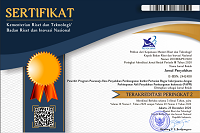Perilaku Anak Jalanan dan Strategi Pengentasannya di Bandung, Bogor, dan Jakarta
Abstract
Street child problems, like iceberge phenomenon, of which the regional pockets, the distribution and the age tremendously increase day by day. Since 1997 the government of Indonesia through the Social Ministry has been carrying out efforts to overcome the problems, but up to now the efforts have not yielded the expected results because of the limited information of the problems. The present research was addressed to provide informations on the phenomenon profiles of street children and strategies for their elimination in Bandung, Bogor and Jakarta. Data were collected using structured interviews, focus group discussion and direct observation. The collected data were analysed using parametric and non-parametric statistics. Population were street children, 5-21 years of age. Sample in each region was consisted of 75 persons, 50 males and 25 famales, drawn using cluster random sampling technique, and 25 parents of the respondens as a cross check. The influence of family background on the street children behavior, direct or indirectly, was more obvious compared to that of environmental background. The latter was indirect through sociologic characteristics of the street children particularly on the non formal education. Strategy for elimination of the street children could be equally applied for the whole regions, except for its approach, which can use the TRIBINA, which means Human Building, Environmental Building and Efforts Building could be employed.
Downloads
Authors who publish with this journal agree to the following terms:
- Authors retain copyright and grant the journal right of first publication with the work simultaneously licensed under a

This work is licensed under a Creative Commons Attribution 4.0 International License that allows others to share the work with an acknowledgement of the work's authorship and initial publication in this journal. - Authors are able to enter into separate, additional contractual arrangements for the non-exclusive distribution of the journal's published version of the work (e.g., post it to an institutional repository or publish it in a book), with an acknowledgement of its initial publication in this journal.
- Authors are permitted and encouraged to post their work online (e.g., in institutional repositories or on their website) prior to and during the submission process, as it can lead to productive exchanges, as well as earlier and greater citation of published work (See The Effect of Open Access).















